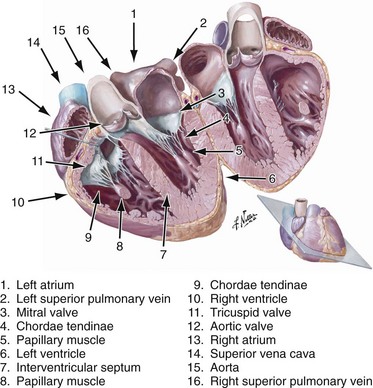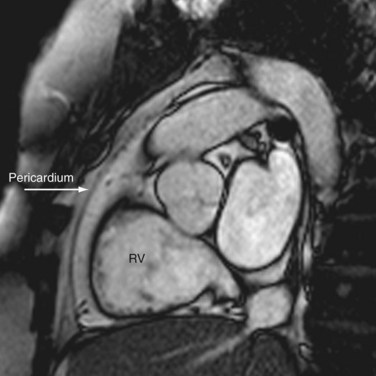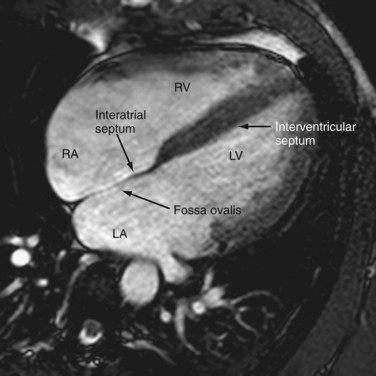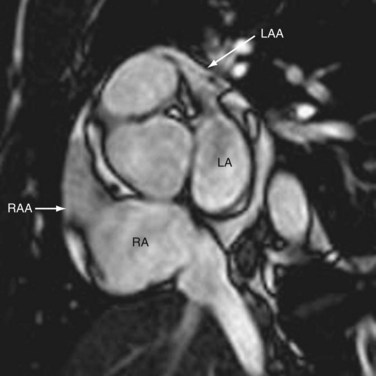CHAPTER 2 Cardiac Anatomy
The heart has four chambers, two superior atria and two inferior ventricles. A fibrous interatrial septum divides the atria and a muscular interventricular septum divides the ventricles (Figs. 2-1 and 2-2). The heart is enveloped in a serous membrane, the pericardium, which has a visceral and parietal layer that contains a minimal amount of fluid.

(From Netter Illustration Collection at www.netterimages.com © Elsevier Inc. All Rights Reserved. The author has added new labels to this image that are not part of the original image.)
Multidetector computed tomography (CT) and magnetic resonance imaging (MRI) have revolutionized cardiac imaging. The multiplanar capability of cross-sectional imaging enables the accurate diagnosis of cardiac pathology and function, and a thorough knowledge of cardiac anatomy is essential to interpret these examinations correctly. This chapter reviews cardiac anatomy, with an emphasis on the perspective of CT and MRI. Coronary artery anatomy will be covered in Chapter 3.
NORMAL ANATOMY
General Anatomic Descriptions
Pericardium
The pericardium is a two-layered membrane that envelops all four cardiac chambers and the origins of the great vessels. It consists of parietal and visceral layers separated by a small amount of serous fluid—normally, about 15 to 50 mL—that is mainly an ultrafiltrate of plasma. The pericardium limits the spread of infection and inflammation from adjacent mediastinal structures, prevents excessive dilation of the heart, and reduces friction between the heart and surrounding structures.1
CT and MRI are excellent modalities for imaging the pericardium. The normal pericardium is less than 2 mm thick and requires the presence of epicardial fat or pericardial fluid to distinguish it from the myocardium.2 The pericardium is visible over the right atrium and right ventricle but the lateral and posterior walls of the left ventricle are often bare (Fig. 2-3). Left atrial enlargement is attributed to its partial coverage by pericardium. Several pericardial recesses may be visible on CT and MRI scans. Small amounts of fluid may be present in these structures in healthy individuals. The superior pericardial recess, a curvilinear structure wrapped around the right wall of the ascending aorta, may be mistaken for an aortic dissection, mediastinal mass, lymph node, or thymus. The transverse pericardial sinus, which is dorsal to the ascending aorta, sometimes may be mistaken for aortic dissection or lymphadenopathy (Fig. 2-4). The oblique pericardial sinus, which is situated behind the left atrium, may be misinterpreted as esophageal lesions or bronchogenic cysts. Knowledge of the locations of these recesses can help the imaging specialist differentiate them from abnormal lesions.3

 FIGURE 2-3 Short-axis bSSFP image illustrating the normal pericardium anterior to the right ventricle.
FIGURE 2-3 Short-axis bSSFP image illustrating the normal pericardium anterior to the right ventricle.
Atria
Right Atrium
The atria are divided into a venous component, vestibule of the atrioventricular valve, septal component, and appendage. The right atrium is embryologically derived from the sinus venosus and primitive auricle, with the former evolving into the venous component and the latter into the appendage. These corresponding parts are separated internally by a muscular band called the crista terminalis (Fig. 2-5), which could be misinterpreted as a right atrial mass.4 The posterior part of the atrium is derived from the sinus venosus and has a smooth interior, whereas the appendage, derived from the primitive auricle, has trabeculations and pectinate muscles that branch from the crista terminalis at right angles (Fig. 2-6). The venous component of the right atrium receives the superior and inferior vena cavae on its posterior surface and the coronary sinus at its junction with the septal component, just above the posterior interventricular groove (Fig. 2-7). The right atrial appendage has a triangular appearance and is best appreciated ventral to the junction of the superior vena cava (SVC) and right atrium. The smooth-walled vestibule incorporates the attachments for the tricuspid valve. The right atrium forms the right lateral border of the heart on a chest radiograph and enlargement of the appendage may be seen in the retrosternal space.
Left Atrium
The left atrium forms the upper posterior heart border on chest radiographs and lies just beneath the carina anterior to the esophagus. This latter characteristic makes it an ideal window in transesophageal echocardiography. The left atrium is also derived from the sinus venosus and the primitive auricle, with similar components. The posteriorly located smooth-walled venous component receives the four pulmonary veins (Fig. 2-8). The vestibule is also smooth-walled and supports the leaflets of the mitral valve.
Stay updated, free articles. Join our Telegram channel

Full access? Get Clinical Tree




 FIGURE 2-1
FIGURE 2-1 FIGURE 2-2
FIGURE 2-2
 FIGURE 2-4
FIGURE 2-4
 FIGURE 2-5
FIGURE 2-5
 FIGURE 2-6
FIGURE 2-6
 FIGURE 2-7
FIGURE 2-7